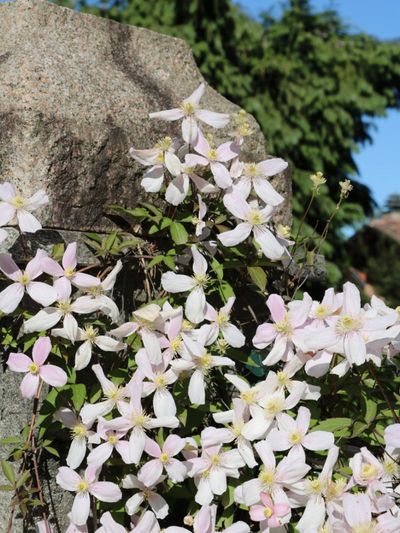Growing Vines in the Northwestern U.S.
Native Pacific Northwest flowering vines are an excellent choice for the landscape. They add vertical dimension to the garden, attract hummingbirds and butterflies, and because most vines grow rapidly, make wonderful privacy screens. Pacific Northwest native vines have already acclimated to local conditions such as weather, soil, and rainfall. This means they are more likely to thrive versus nonnative, subtropical vines, which may do well through the growing season only to die during the winter. Native vines also are likely to require less maintenance because they are already hardy to the environment.
Clematis Vines for the Pacific Northwest
If you reside in the Pacific Northwest, then you are familiar with clematis, specifically Clematis armandii. This vine is a rigorous, early blooming clematis with fragrant blossoms that reliably return year after year and stay green year-round. If you love this clematis but want a different look, there are several other varieties to choose from that are suitable as vines for this area.
Wisley Cream (Clematis cirrhosa) sports a creamy bell-shaped bloom from November through February. As temperatures cool, the glossy green leaves become a dappled bronze.Avalanche (Clematis x cartmanii) lives up to its name with a riot of white blooms in early spring. In the center of each snowy bloom is a dot of eye-popping chartreuse. The foliage on this clematis is almost lace like.Clematis fasciculiflora is another evergreen and a rare cultivar. Its foliage departs from the usual glossy green and is, instead, striated with silver veining that transitions from purple to rust through green hues. It produces bell-shaped blooms in early spring.
Other Pacific Northwest Native Vines
Orange honeysuckle (Lonicera ciliosa): Also called western honeysuckle, this vine produces red/orange flowers from May through July. Try growing If you want to attract hummingbirds.Hedge false bindweed (Calystegia sepium): Produces morning-glory-like blooms from May to September. Like morning glory, this vine has a tendency to spread and may actually turn into a pest.Woodbine (Parthenocissus vitacea): Woodbine is tolerant of most soils and any type of light exposure. It blooms in a variety of hues from May to July.Whitebark raspberry (Rubus leucodermis): Boasts white or pink blooms in April and May. It is thorny like a raspberry bush and makes not only a privacy barrier but a security device.
Don’t forget the grapes. Riverbank grape (Vitus riparia) is a fast-growing and long-living vine that is very hardy. It blooms with yellow-green blossoms. California wild grape (Vitus californica) also bears yellow-green blooms. It is very aggressive and requires maintenance if you don’t want it crowding out other plants. There are other vines that, while not native to the region, have a proven history of thriving in the Pacific Northwest. A few of these include:
China blue vine (Holboelia coriacea)Evergreen climbing hydrangea (Hydrangea integrifolia)Henry’s honeysuckle (Lonicera henryi)Star jasmine (Trachelospermum jasminoides)
Last but not least, let’s not forget passionflower. Blue passionflower (Passiflora caerulea) is almost as common a vine as Clematis armandii. This vine is extremely fast growing, incredibly hardy, and bears large, cream-colored blooms with purple-blue coronas. In the mild regions of the Pacific Northwest, USDA zones 8 and 9, the vine remains an evergreen. Flowers beget large, orange fruit that, while edible, are fairly tasteless.
